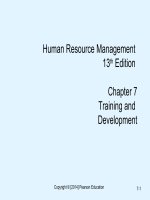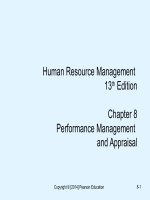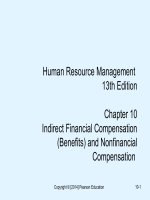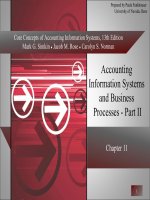Human resource 1e by denisi griffin chapter 11
Bạn đang xem bản rút gọn của tài liệu. Xem và tải ngay bản đầy đủ của tài liệu tại đây (712.94 KB, 30 trang )
©
© 2012
2012 South-Western,
South-Western, Cengage
Cengage Learning,
Learning, Inc.
Inc.
All
All rights
rights reserved.
reserved.
Prepared
Prepared by
by Joseph
Joseph B.
B. Mosca,
Mosca, Monmouth
Monmouth University
University and
and
Marla
Marla M.
M. Kameny,
Kameny, Baton
Baton Rouge
Rouge Community
Community College
College
PowerPoint
PowerPoint Presentation
Presentation Design
Design by
by Charlie
Charlie Cook
Cook
The
The University
University of
of West
West Alabama
Alabama
Learning Objectives
After studying this chapter, you should be able to:
1. Describe the role of labor unions in organizations.
2. Identify and summarize trends in unionization.
3. Discuss the unionization process.
4. Describe the collective-bargaining process.
5. Discuss how labor agreements are negotiated.
6. Describe how impasses get resolved and agreements are
administered.
7. Discuss emerging labor issues in the twenty-first century.
© 2012 South-Western, Cengage Learning, Inc. All rights reserved.
11–2
Labor Unions’ Role in Organizations
• Labor Relations
The process of dealing with employees who
are represented by a union.
• Labor Union
A legally constituted group of individuals
working together to achieve shared, jobrelated goals, including higher pay and
shorter working hours.
© 2012 South-Western, Cengage Learning, Inc. All rights reserved.
11–3
What is Collective
Bargaining?
The process by which managers and
union leaders negotiate acceptable
terms and conditions of employment
for workers represented by the union.
© 2012 South-Western, Cengage Learning, Inc. All rights reserved.
11–4
A Historical Time Line of
Unionization in the United States
© 2012 South-Western, Cengage Learning, Inc. All rights reserved.
11–5
Historical Development of Unions
• Knights of Labor
Expanded its goals and its membership to include
workers in numerous fields rather than a single
industry.
• American Federation of Labor (AFL)
Focused its efforts on improved working conditions
and better employment contracts rather than getting
involved in legislative and political activities.
• Congress of Industrial Organizations (CIO)
Early union which focused on organizing employees
by industry, regardless of their craft, skills, or
occupation.
© 2012 South-Western, Cengage Learning, Inc. All rights reserved.
11–6
Beyond the Book:
Types of Union-Management Relations
Conflict, each challenges the other.
Armed truce, each views the other as antagonistic.
Power bargaining, each side tries to gain.
Accommodation, each tolerates the other.
Cooperation, both work together.
Collusion, both cooperate to the point of adversity.
© 2012 South-Western, Cengage Learning, Inc. All rights reserved.
11–7
Legal Context of Unions
• National Labor Relations Act of 1935
Commonly referred to as the Wagner Act
Granted power to labor unions on a footing
more equal with managers in terms of the
rights of employees.
• National Labor Relations Board (NLRB)
Administers most labor laws in the United
States.
© 2012 South-Western, Cengage Learning, Inc. All rights reserved.
11–8
Legal Context of Unions (cont’d)
• The Labor Management Relations Act
Also known as the Taft-Hartley Act (1947)
Was a response to strikes in the years
following World War II.
Curtailed and limited union power, including
closed shop agreements under which only
workers who are already union members may
be hired by the employer.
© 2012 South-Western, Cengage Learning, Inc. All rights reserved.
11–9
Legal Context of Unions (cont’d)
• Union Shop Agreement
Requires that nonunion applicants can be
hired, but they must join the union within a
specified time to keep their jobs.
• Landrum-Griffin Act (Labor Management
Reporting and Disclosure Act) of 1959
Focused on eliminating various unethical,
illegal, and undemocratic union practices.
© 2012 South-Western, Cengage Learning, Inc. All rights reserved.
11–10
Union Structures
• Local Unions
Are organized at the level of a single
company, plant, or small geographic region.
• Shop Steward
Is an elected position in a local union.
Is a regular employee who functions as a
liaison between union members and
supervisors.
© 2012 South-Western, Cengage Learning, Inc. All rights reserved.
11–11
The Basic Structure of a Union
© 2012 South-Western, Cengage Learning, Inc. All rights reserved.
11–12
Trends in
Union
Membership
© 2012 South-Western, Cengage Learning, Inc. All rights reserved.
11–13
Trends in Union-Management
Relations
• Gradual decline in unionization in the U.S.
Gradual decline in unionization in the U.S.
Has been accompanied by significant trends
in union-management relations.
• In the automotive industry, unions remain
strong and have large memberships.
Unions recognize their declining membership,
and now work with management, rather than
against it.
© 2012 South-Western, Cengage Learning, Inc. All rights reserved.
11–14
Why Employees Unionize
• Employees believe they will be better off
as a result of joining a union.
• Employees unionize when they are
dissatisfied their jobs and they believe that
the union can help make their jobs better.
© 2012 South-Western, Cengage Learning, Inc. All rights reserved.
11–15
Steps Employees
Use to Form a
Union
© 2012 South-Western, Cengage Learning, Inc. All rights reserved.
11–16
What Is a
Bargaining Unit?
• Bargaining Unit
A defined group of employees who are eligible
for representation by the union.
The union becomes the official bargaining
agent for the bargaining unit when it is
certified by the NLRB.
© 2012 South-Western, Cengage Learning, Inc. All rights reserved.
11–17
The Collective Bargaining Process
• How should a union prepare for
bargaining?
It should examine the financial health of the
employer.
• Bargaining Items
Mandatory items
Items that must be bargained
– Wages, working hours, and benefits
benefits
Permissive items
Items that may be included if both parties agree.
© 2012 South-Western, Cengage Learning, Inc. All rights reserved.
11–18
Decertification of Unions
• For decertification to occur, two conditions
must be met:
No labor contract can currently be in force
(the previous agreement must have expired).
The union must have served as the official
bargaining agent for the employees.
© 2012 South-Western, Cengage Learning, Inc. All rights reserved.
11–19
The Bargaining Zone
© 2012 South-Western, Cengage Learning, Inc. All rights reserved.
11–20
When Negotiations Breakdown
• Strike
Occurs when employees walk off their jobs
and refuse to work.
• Picketing
Occurs when union workers march at the
entrance to the employer’s facility with signs
explaining their reasons for striking.
• Boycott
Occurs when union members agree not to buy
products of a targeted employer.
© 2012 South-Western, Cengage Learning, Inc. All rights reserved.
11–21
When Negotiations Breakdown
(cont’d)
• Slowdown
Slowdown
Occurs when workers perform their jobs at a
much slower pace than normal.
• Wildcat Strike
Is an unauthorized job action usually
undertaken in response to a perceived
injustice on the part of management.
• Lockout
Occurs when an employer denies employees
access to the workplace.
© 2012 South-Western, Cengage Learning, Inc. All rights reserved.
11–22
Resolving Labor Disputes
• Impasse
A situation in which one or both parties
believe that an agreement is not imminent.
• Resolving an Impasse: Mediation
A neutral party (the mediator) listens to and
reviews information presented by both sides.
The mediator makes recommendations and
provides advice to both parties about what
should be done.
© 2012 South-Western, Cengage Learning, Inc. All rights reserved.
11–23
Resolving Labor Disputes (cont’d)
• Arbitration
Both sides agree in advance that they will
accept the recommendations made by an
independent third party.
• Final-offer Arbitration
The parties bargain until impasse and then
the two parties’ final offers are submitted to
the arbitrator.
© 2012 South-Western, Cengage Learning, Inc. All rights reserved.
11–24
Administering Labor Agreements
• Collective Bargaining Contracts
Define how the provisions of the labor
agreement will be administered and enforced:
Seniority
Overtime allocations
© 2012 South-Western, Cengage Learning, Inc. All rights reserved.
11–25









